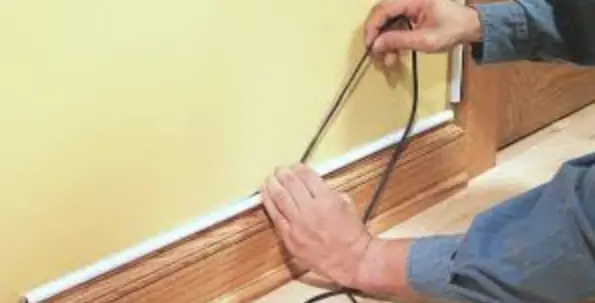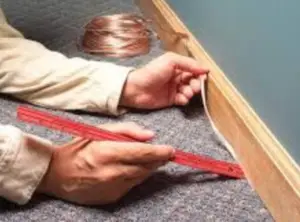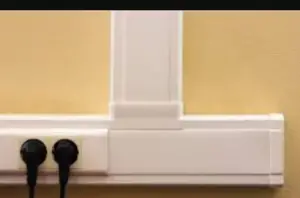
Stylish solutions for cluttered cables and how to hide your cables
How to hide clustered electronic cables or wires in 2023

Our electronics may make living easier, but they don’t necessarily make it easy on the eyes. From plugs to chargers and cords, electronic clutter is taking over our homes at an alarming speed. Thankfully, new technology and a bit of DIY innovation is helping to turn the tide on the sea of cables. “People do not want to see cords everywhere so we are getting clever at hiding them,” Julie Rees, lead designer at Sojo Design says. “As they vary in colours and lengths, they’re also tripping hazards.”
Here are the best ways to avoid any accidents and save your space with a few quick and easy changes.
1. Power planning
If you’re about to undertake a renovation or new build, it’s best to plan ahead around what electronics you’ll need and where. Julie emphasises the importance of “spatial design and floor planning so we can determine where lamps or cords of any sort are discreet.” If you know where you’d want a certain lamp to go or your TV, make sure that a power point is close by to limit extension cords snaking around your space. Plan your furniture placement and work around accordingly; you’ll be thankful when you no longer have to use extension cords just to charge your phone at night.
Power points built into floors are becoming a hot option, especially since they can be disguised by a recessed lid to preserve your floors. Importantly, they’re perfect for flexible living arrangements, such as using laptops around dining tables, and then packing away your work in time for dinner.
2. Cover those cables
Cable covers are going to be your new best friend, trust us. Thread the cable inside these plastic tubes or wrap the cover around your cable, depending on what type you purchase, and away you go. These are perfect for running under rugs, or along wall skirting, especially if you get a colour that matches your walls. Cable covers help to reduce trip hazards as well as protect the cables themselves from foot traffic wear and tear. You can even get covers that can conceal several wires at once, helping to maintain a smooth and seamless appearance in your home.
3. Living room hacks
This social area is never easy, especially because it’s a space open to the scrutiny of guests but cords can be conquered, even here. “On occasion, we need to get cords cut down for lamps so there is less excess on floor,” Julie says. While it is possible to shorten a lamp cord in a DIY afternoon, it’s best to leave it to an electrician for safety reasons and to avoid possibly damaging your favourite piece. On the flip side, cordless lamps have been growing in popularity overseas, with hopes they will soon reach our shores in a meaningful way.
But if you have a lamp with a long cord, all hope is not lost. Sometimes the best way to deal with cables is to hide them in plain sight, all it involves is a bit of adhesive hook trickery. Small, transparent adhesive hooks can be purchased from hardware stores and attached along furniture lines, whether that’s to the back of a sofa or creeping down a coffee table leg.
Run your cable through it until it subtly reaches the socket. This’ll elevate cords above tripping level while offering a discreet look overall. To really get the most out of this method, paint the cord or cord cover to match the colour of whatever furniture it runs down, tricking the eye using a camouflage effect. Make sure to paint match so that the cord or cord cover blends in. Leftover furniture fabric swatches can also be used to hide wires.

4. Box it up
In our experience, the TV area is always hit hardest by disorder. A rattan basket can work wonders here, simply thread cords through the basket handles and hide them inside. If you don’t have basket handles, simply cut an opening through the wicker. Inside the container, your wifi router can whir on undeterred, but outside paints a different picture. If you don’t have a basket, even a painted shoebox will help contain any tripping hazards.
On a smaller scale, a much sneakier version of this hack is to grab a sturdy hardback book and cut out a secret enclosure that can fit your phone to charge at night or to hide the modem in the lounge. Several small craft vendors also sell fake books if you don’t have the heart or skills to take scissors and craft knife to your favourite classic.
5. Kitchen hacks
We’d all love a butler’s pantry to be able to hide away the mess of domestic life, but if your kitchen doesn’t extend to that kind of luxury, Julie recommends hiding power points in drawers or on side surfaces as opposed to the back wall and obvious places. Pop-up power outlets built into your countertop are also a great option for discreet, aesthetic living.
If you enjoy displaying your appliances, such as a stand mixer or blender, but don’t love the trail of cords that comes with them, then this hack is for you. Stick an adhesive hook on the back of the appliance, then wind up the cord and strap it on the hook. When in use, unravel to plug in. Avoid doing this for any appliance that heats up, such as a toaster, but otherwise it’s the perfect kitchen hack for a couple of dollars.
You can also clear cords off your counter by propping up small appliances on purpose-built stands. Place coffee essentials or toast accessories around the area for ease of use, all the while knowing the cords are secretly stashed beneath.
6. No wires, no worries
If you often find yourself charging your phone as you cook, Julie advises “introducing wireless charging surfaces in the kitchen” to help with clutter. Wireless charging can normally be conducted through any non-metallic benchtop, depending on thickness. Stick them on the underside of the overhang or the roof of a drawer so they’re concealed, then when you place a phone on top of your counter, you’ll be able to effortlessly charge, no wires needed. This hack will also work well with bedside tables or coffee tables, whenever you need a quick device charge during your day.
Finally, if hiding your cords isn’t an option, lean into the exposed cable look. Think Brooklyn loft, with dangling wires and brushed metal pieces when it comes to interiors. Some rough-edged concrete accessories and Edison bulbs will add to the warehouse-chic look, perhaps brick wallpaper.
It’s all about “faking it until you make it”.
Frequently Asked Questions
How do you hide cables in plain sight?

How do I hide cable wires in my room?
How do you attach cables to a wall without nails?
How do you hide my cables when my TV is on the wall?
How can I hide wires without a false ceiling?
How do you tape a cable to the wall?
How do I hide something from my parents?
How do you hide TV wires with decor?
Is it OK to leave wires exposed?





Leave a Reply